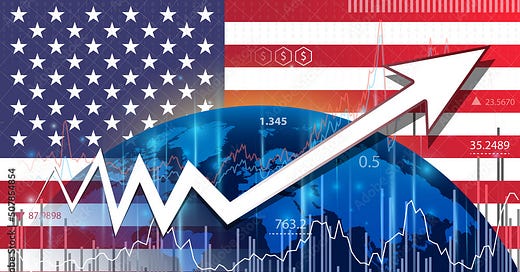Don't Buy the Recession Hype: The American Economy Is Still Standing Tall
Beneath the Headline Number, Demand Remains Strong
This week’s headlines were loud: “U.S. economy contracts for first time in nearly three years.” Real GDP dipped -0.3% in Q1 2025, and with that, a fresh wave of recession talk swept across cable panels and market newsletters. But the story behind the headline tells a very different tale—one of strength, not softness.
The top-line GDP number, while technically negative, masks the real dynamics beneath the surface. When you strip out inventory fluctuations, government spending, and net exports—all volatile and often misleading components—you get a clearer measure of core demand: final sales to private domestic purchasers. That number rose a healthy +3.0%.
That’s not recessionary. That’s resilience.
Even more telling, business investment surged across the board:
Equipment: +27.0%
Structures: +10.0%
Intellectual Property Products: +7.8%
Firms aren’t bracing for a downturn—they’re planning for growth. These are not defensive moves; they’re forward-looking capital bets, especially in manufacturing and tech.
So what dragged GDP into negative territory?
Three temporary—and misleading—factors:
Front-loaded imports ahead of new tariffs (trade timing noise).
A pullback in defense-related federal spending.
Inventory drawdowns, typical of Q1 adjustments.
This isn’t structural weakness. It’s accounting turbulence.
We've seen this pattern before. In Q1 of 2015, GDP posted a -0.7% print, triggering recession chatter. But under the hood, demand remained solid—and growth snapped back the following quarter. We're likely seeing a similar setup today.
Early Q2 indicators are already pushing back on the pessimism:
April ISM Manufacturing beat expectations at 48.7, with new orders improving.
April jobs report outperformed: 177,000 jobs added vs. 138,000 expected.
The S&P 500 is on track for its longest winning streak since 2004.
In other words: momentum is real, even if the Q1 data didn’t show it at first glance.
To be clear, risks remain. Rates are still elevated. Trade friction looms. But to call this a recession—or even a stall—is to ignore the underlying story of a durable U.S. economy still adjusting to post-COVID realities, a new trade regime, and a shifting global order.
The lesson? Don’t confuse a quarterly headline with a long-term trend. The American economy is evolving. What looks like weakness may in fact be the early stages of realignment.
Not all contractions are created equal—and this one looks more like recalibration than retreat.




